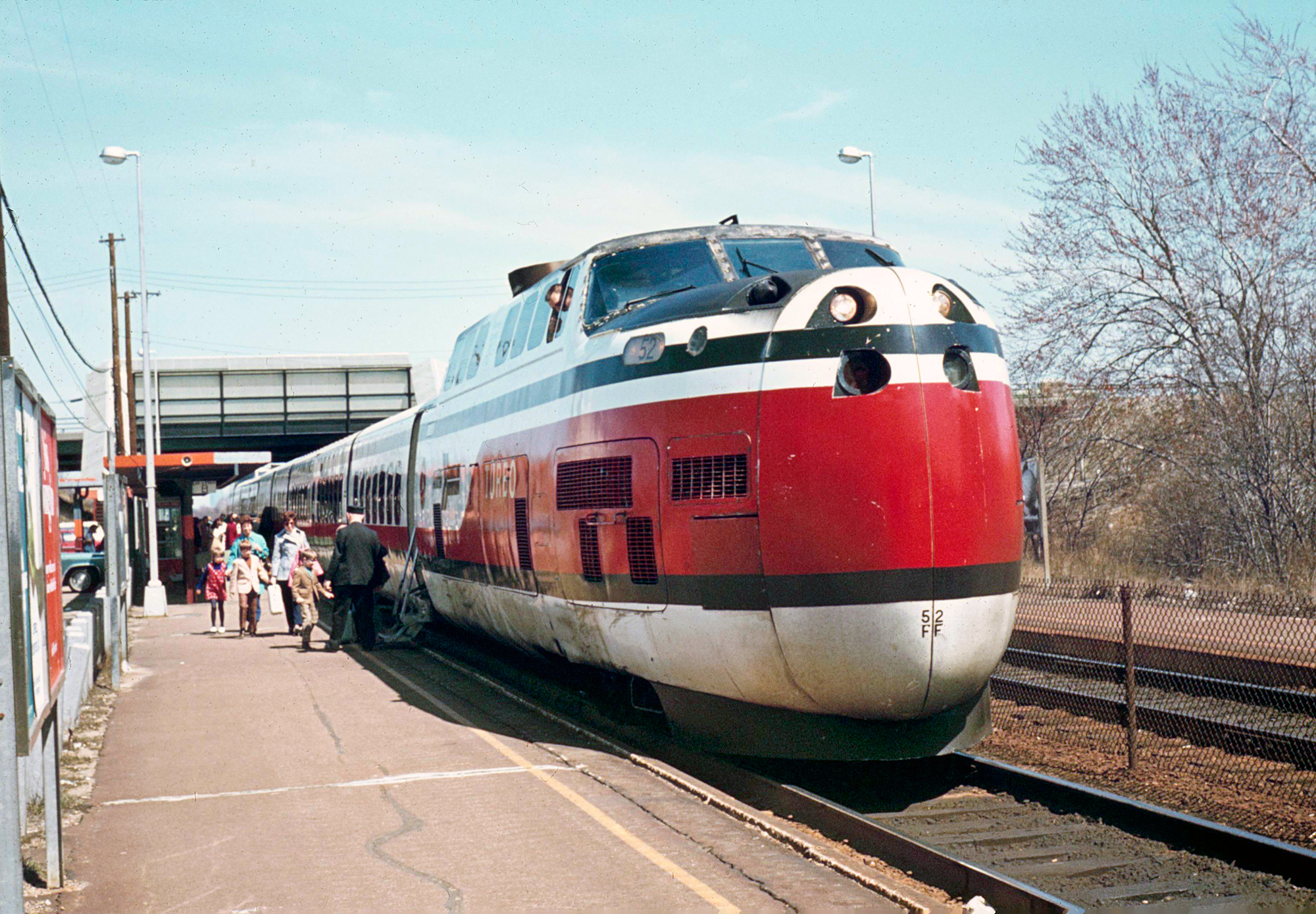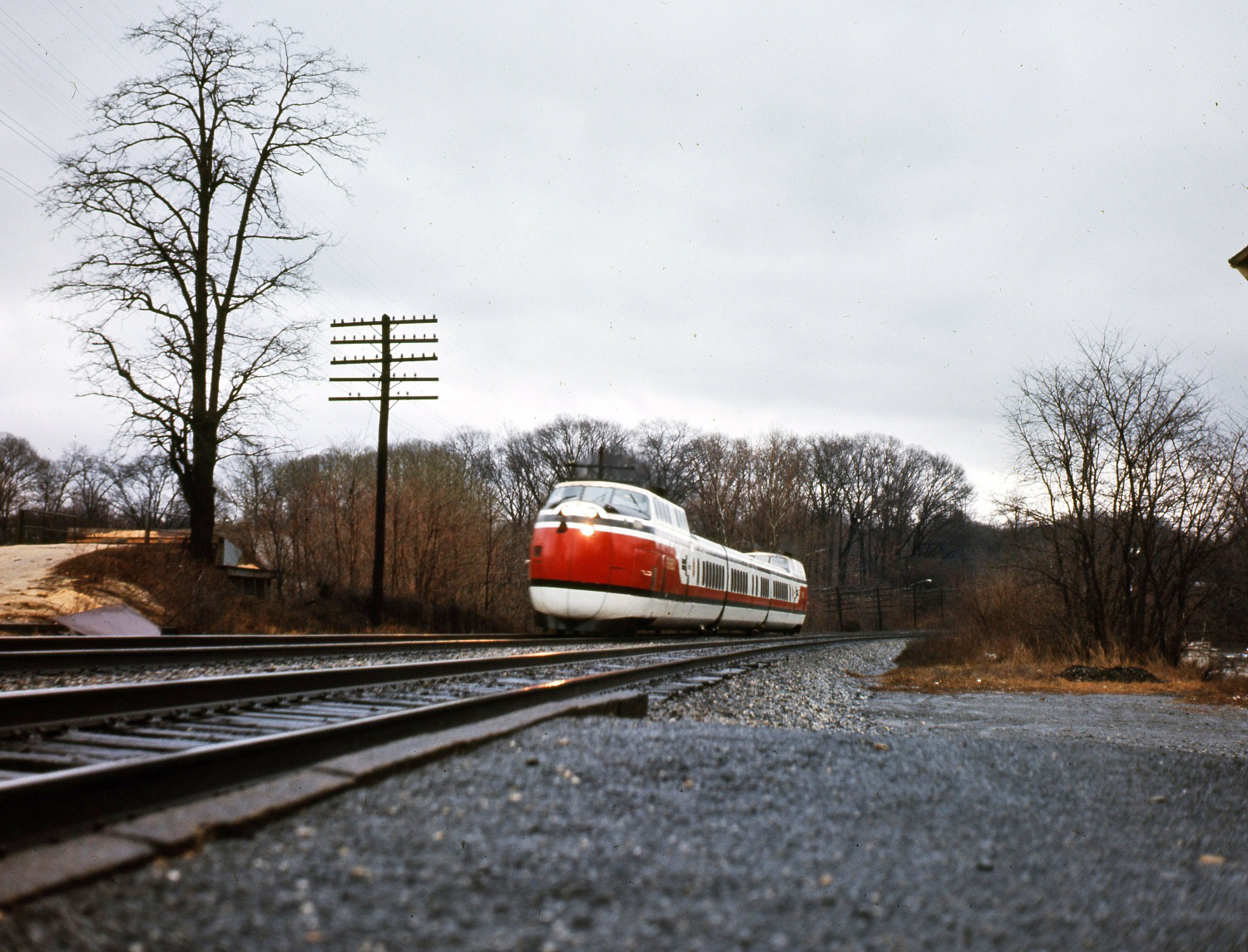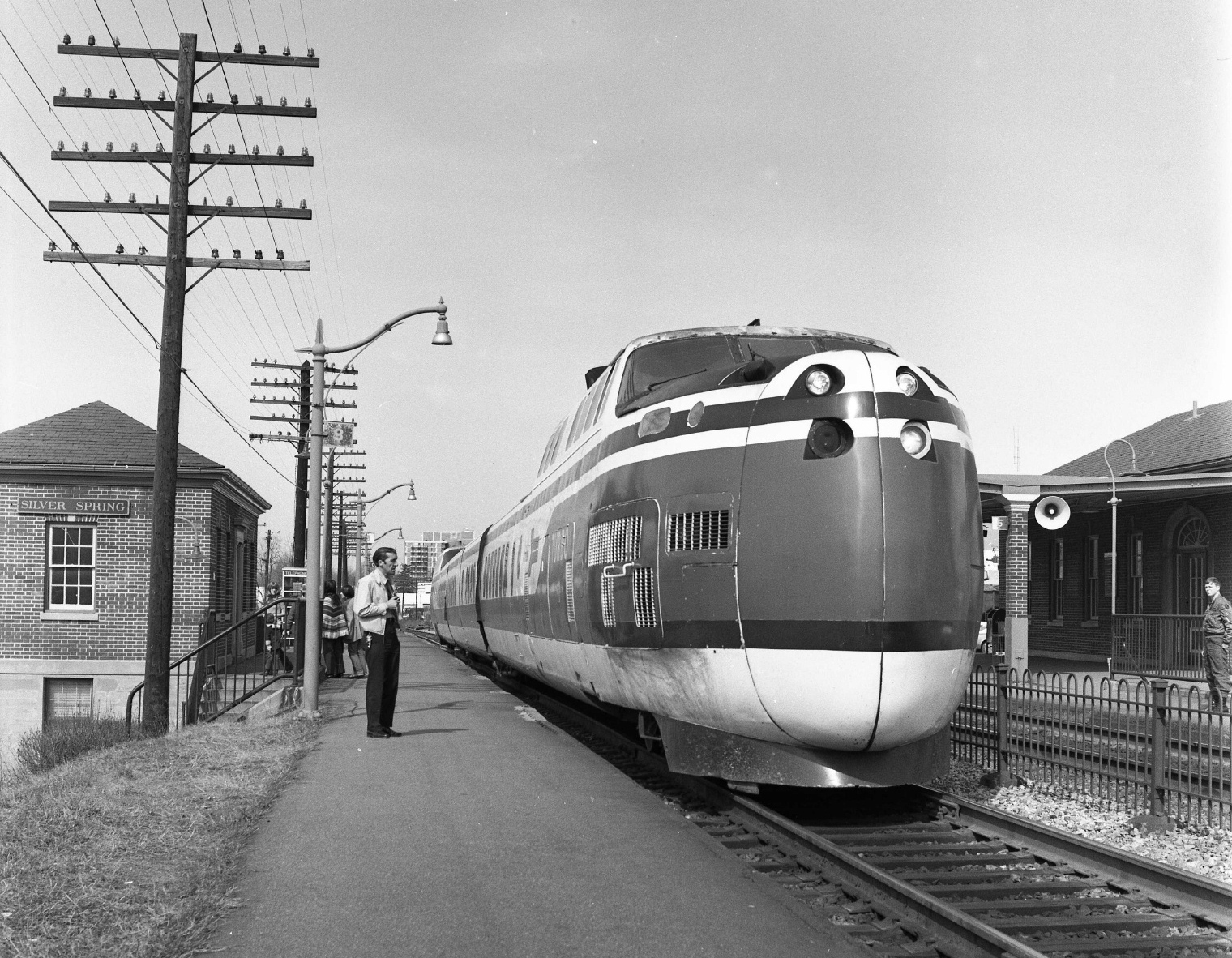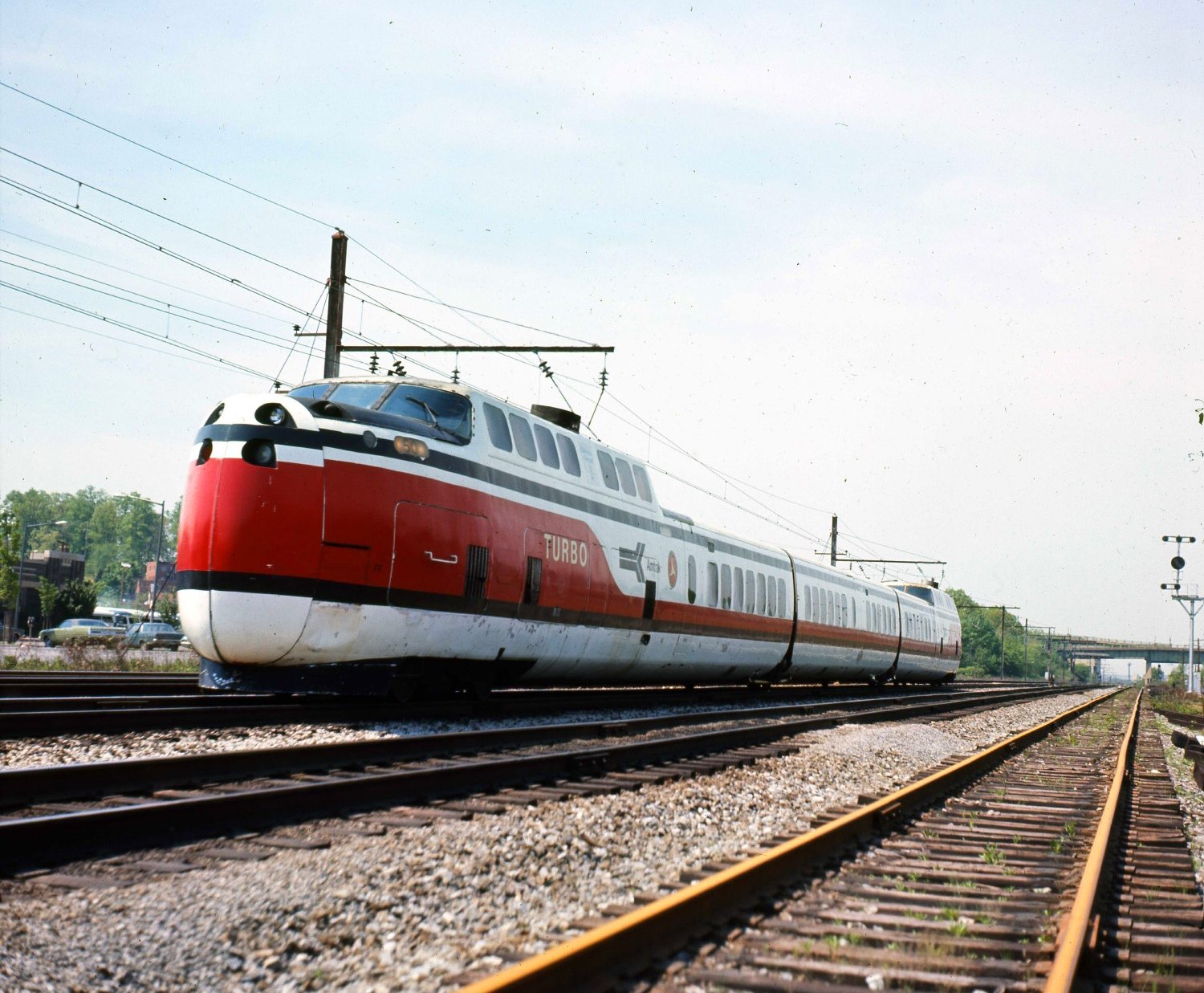- Home ›
- Amtrak ›
- TurboTrain
The "TurboTrain": A United Aircraft Corporation Concept
Last revised: September 5, 2024
By: Adam Burns
By the 1960s interest in passenger rail travel was declining rapidly
with the general public.
The United Aircraft Corporation saw a potential market to develop a new train to lure patrons back to the rails, such as had been done in the 1930s with Burlington's Zephyr and Union Pacific's M-10000.
As such, the company came up with the TurboTrain, a high speed gas turbine design that could zip along well over 100 mph with early tilting technology.
It first hit the rails in the late 1960s with testing done in the northeast. At the same time the new streamliner was operating in the United States it was also being tried in Canada on the VIA Rail system.
The train's cruising speed was quite impressive but it also showcased serious flaws, particularly with its tilting mechanism and never saw widespread use.
After the creation of Amtrak the trainsets survived for nearly a decade before being removed from the property with Canada's surviving a few years longer. All were ultimately scrapped.
 Amtrak's "Turbo Train" boards in Canton, Massachusetts (Route 128 Station), heading west, during April of 1973. Robert Newbegin photo. American-Rails.com collection.
Amtrak's "Turbo Train" boards in Canton, Massachusetts (Route 128 Station), heading west, during April of 1973. Robert Newbegin photo. American-Rails.com collection.The UAC TurboTrain was unique for two primary reasons; its ability to tilt along with the aircraft engine that was used as a prime mover.
During the 1960s railroads were becoming increasingly disinterested in operating passenger trains. By contrast, the public was far more interested in the increasingly more efficient automobile along with new interstates currently under construction at the time.
With sales declining and expenses climbing the industry simply wanted out of the passenger business. However, a few efforts were put forth by various companies for a second renaissance to regain public interest in rail travel
It was also spurred, in part, by the High Speed Ground Transportation Act of 1965 in the United States as well as interested from Canadian National.
One came from the United Aircraft Corporation which looked to develop a high speed, lightweight trainset based on tilting technology that dated back to the 1950s and developed by the Spanish company Talgo.
The UAC's design, though, would be based from work that the Chesapeake & Ohio Railway had been testing with tilting by having power cars on each end with cars in between.
Since the trainsets would be semi-permanently coupled and not meant to be used in any type of interchange they used common trucks (one truck which attached to each end of the car) similar to the early streamliners (this setup is now quite common for all high speed trainsets).
For power the TurboTrain utilized a turboprop aircraft engine, the PT6.
Developed by the Pratt & Whitney Canada, a division of the UAC's Pratt & Whitney company based in East Hartford, Connecticut, it was modified for use in rail service.
Today, Pratt & Whitney remains a highly respected and reputable manufacturer of aircraft engines and other systems.
 Amtrak's "Potomac Turbo," utilizing a UAC "Turbo Train," runs the Baltimore & Ohio (Washington, D.C. - Parkersburg, West Virginia) through Maryland during February of 1972. Jerry Custer photo.
Amtrak's "Potomac Turbo," utilizing a UAC "Turbo Train," runs the Baltimore & Ohio (Washington, D.C. - Parkersburg, West Virginia) through Maryland during February of 1972. Jerry Custer photo.At the time the engine was actually quite new, developed only in the early 1960s. For railroad use the prime mover could produce about 400 horsepower, which one placed in each power car.
The U.S. trainsets were designed with two power cars and three coaches with Canadian trainsets featured five coaches.
In both countries the TurboTrain debuted in 1968 and could operate at speeds of up to 160 mph although generally they did not top 120 mph while in regular service.
For a gas-turbine design the trainsets still holds the world speed record of nearly 171 mph (this was accomplished using just two power cars and a single coach), which was accomplished in December, 1967 along the Pennsylvania Railroad's main line in New Jersey, a year before the streamliner went into service.
The carbody of the train was somewhat unique although rather large and bulbous for rail service.
 Amtrak's UAC "Turbo Train" with the "Potomac Turbo" at the B&O's station in Silver Spring, Maryland during March of 1972. Jerry Custer photo.
Amtrak's UAC "Turbo Train" with the "Potomac Turbo" at the B&O's station in Silver Spring, Maryland during March of 1972. Jerry Custer photo.In truth it looked quite similar to an airliner with a large lead nose, turret cab, and a body that took the shape of an aircraft's fuselage.
Unfortunately, the train's tilting mechanism was a constant maintenance headache and the price tag was simply not in anyone's budget, at least for serious consideration in regular use.
In the United States the federal government tested two trainsets, numbered DOT1 and DOT2, which were built by the Pullman Company during its final years constructing cars for the industry (in Canada, the trainsets were built by the Montreal Locomotive Works, an Alco subsidiary).
The two sets were acquired by the New Haven Railroad during early 1968 and put into regular service between Boston and New York City
After the Penn Central merger on February 1 of that year they retained their original routing and were then acquired by Amtrak on May 1, 1971 when the national passenger carrier began services on that date.
Under Amtrak ownership they were given an all white livery with blue and red pinstripes and continued to be used until September, 1976 when they were finally retired altogether.
Interestingly, they remained on Amtrak's roster until 1980 when they were sold for scrap. The six sets used in Canada by VIA and CN survived until 1982 when they too were scrapped.
Amtrak continued to experiment with various high speed train concepts during the 1970s, the most notable and successful of which was the Turboliner built by a French company that continued to see use until the early 2000s.
 Amtrak's westbound "Potomac Turbo" departs Washington Union Station as it passes F Tower on its way to Parkersburg during the spring of 1972. Jerry Custer photo.
Amtrak's westbound "Potomac Turbo" departs Washington Union Station as it passes F Tower on its way to Parkersburg during the spring of 1972. Jerry Custer photo.This was discontinued when conflicts with New York state forced the remaining trainsets into retirement (interestingly, it was meant to be overhauled and returned to service).
For the most part, however, Amtrak's testing during the 1970s proved rather futile.
With limited funding and a railroad network that was simply too antiquated to operate high speed trains that were becoming common in European countries such as France and Germany there was little chance of any such technology being used in the United States.
Today, aside from the Acela Express
trainsets, Amtrak still has no type of high speed rail service available
to the traveling public.
Recent Articles
-
Florida Scenic Train Rides In Parrish!
Jan 11, 26 02:59 PM
The Florida Railroad Museum (FRRM) in Parrish offers something increasingly rare in today’s rail landscape: a chance to ride historic equipment over a surviving fragment of an early-20th-century mainl… -
California's - Wine Tasting - Train Rides
Jan 11, 26 02:28 PM
This article explores the charm, routes, and offerings of these unique wine tasting trains that traverse California’s picturesque landscapes. -
Georgia's - Murder Mystery - Dinner Train Rides
Jan 11, 26 02:07 PM
In the heart of the Peach State, a unique form of entertainment combines the thrill of a murder mystery with the charm of a historic train ride. -
Colorado ~ Murder Mystery ~ Dinner Train Rides
Jan 11, 26 01:43 PM
Nestled among the breathtaking vistas and rugged terrains of Colorado lies a unique fusion of theater, gastronomy, and travel—a murder mystery dinner train ride. -
Minnesota Dinner Train Rides In Duluth!
Jan 11, 26 01:32 PM
One of the best ways to feel the region's history in motion today is aboard the North Shore Scenic Railroad (NSSR), which operates out of Duluth’s historic depot. -
Illinois Dinner Train Rides At Monticello!
Jan 11, 26 12:42 PM
the Monticello Railway Museum (MRM) is one of those places that quietly does a lot: it preserves a sizable collection, maintains its own operating railroad, and—most importantly for visitors—puts hist… -
Alabama's - Wine Tasting - Train Rides
Jan 10, 26 09:29 AM
While the state might not be the first to come to mind when one thinks of wine or train travel, the unique concept of wine tasting trains adds a refreshing twist to the Alabama tourism scene. -
Maryland Dinner Train Rides At WMSR!
Jan 10, 26 09:13 AM
The Western Maryland Scenic Railroad (WMSR) has become one of the Mid-Atlantic’s signature heritage operations—equal parts mountain railroad, living museum, and “special-occasion” night out. -
Arkansas Dinner Train Rides On The A&M!
Jan 10, 26 09:11 AM
If you want a railroad experience that feels equal parts “working short line” and “time machine,” the Arkansas & Missouri Railroad (A&M) delivers in a way few modern operations can. -
South Dakota's - Murder Mystery - Dinner Train Rides
Jan 10, 26 09:08 AM
While the state currently does not offer any murder mystery dinner train rides, the popular "1880 Train" at the Black Hills Central recently hosted these popular trips! -
Wisconsin's - Murder Mystery - Dinner Train Rides
Jan 10, 26 09:07 AM
Whether you're a fan of mystery novels or simply relish a night of theatrical entertainment, Wisconsin's murder mystery dinner trains promise an unforgettable adventure. -
Missouri's - Murder Mystery - Dinner Train Rides
Jan 10, 26 09:05 AM
Missouri, with its rich history and scenic landscapes, is home to one location hosting these unique excursion experiences. -
Washington ~ Murder Mystery ~ Dinner Train Rides
Jan 10, 26 09:04 AM
This article delves into what makes murder mystery dinner train rides in Washington State such a captivating experience. -
Kentucky Scenic Train Rides At KRM!
Jan 09, 26 11:13 PM
Located in the small town of New Haven the Kentucky Railway Museum offers a combination of historic equipment and popular excursions. -
Washington "Wine Tasting" Train Rides
Jan 09, 26 08:53 PM
Here’s a detailed look at where and how to ride, what to expect, and practical tips to make the most of wine tasting by rail in Washington. -
Kentucky's - Wine Tasting - Train Rides
Jan 09, 26 08:21 PM
Kentucky, often celebrated for its rolling pastures, thoroughbred horses, and bourbon legacy, has been cultivating another gem in its storied landscapes; enjoying wine by rail. -
Kentucky's - Murder Mystery - Dinner Train Rides
Jan 09, 26 01:12 PM
In the realm of unique travel experiences, Kentucky offers an enchanting twist that entices both locals and tourists alike: murder mystery dinner train rides. -
Utah's - Murder Mystery - Dinner Train Rides
Jan 09, 26 01:05 PM
This article highlights the murder mystery dinner trains currently avaliable in the state of Utah! -
North Carolina Dinner Train Rides At NCTM!
Jan 09, 26 12:51 PM
Tucked into the Piedmont town of Spencer, the North Carolina Transportation Museum is the kind of place that feels less like a typical museum and more like a living rail yard that never quite stopped… -
Tennessee Dinner Train Rides At The TVRM!
Jan 09, 26 12:39 PM
Tucked into East Chattanooga, the Tennessee Valley Railroad Museum (TVRM) is less a “museum you walk through” and more a railroad you step aboard.



















